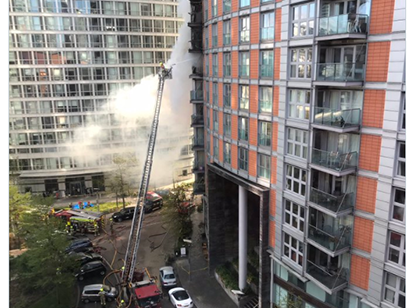A further reflection on the “cladding issues” in the UK.

Over 100 firefighters tackled a blaze for nearly three hours at a block of flats covered in ACM cladding at East London’s New Providence Wharf in Poplar on the morning of 7th May.
The development near Canary Wharf had not yet had its ACM cladding – similar material to that used on the Grenfell Tower and considered a serious flammable risk – removed according to East London Advertiser, three and a half years after the tragedy in West London that saw 72 people die. Since the event, management company, Ballymore, has said the cladding “did not combust and played no part in causing or facilitating the fire”.
Inside Housing has since reported that the smoke detection system installed in the New Providence Wharf block failed when smoke began to spread throughout the building. This meant that doors, which are crucial to a fire compartmentation strategy, in the communal areas did not close, and smoke consequently filled the areas as residents attempted to escape.
20 fire engines were called to the scene, where at least three floors were alight at the 19-storey block at 10AM.
A spokesperson for the Ministry of Housing, Communities and Local Government has said that work was due to be started to remove the cladding on Monday (10th May). Residents, many of who have been responding to the news on social media, highlighted how they had been campaigning for the cladding to be removed since 2017. Several have voiced concerns over the perceived ineffectiveness a Waking Watch strategy played in the evacuation, with security guards or neighbours being cited as the primary response mechanism.
Four children and 38 adults were eventually evacuated from the buildings, where two men have been taken to hospital suffering from the effects of smoke inhalation.
The fire was put out and brought under control by the London Fire Brigade by just after 11:30AM. Reports indicate the flat where the fire started has been destroyed, with the damage visible in the floors above as well.
